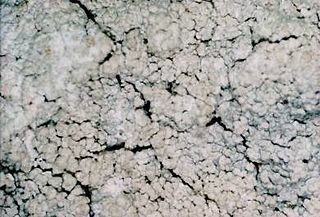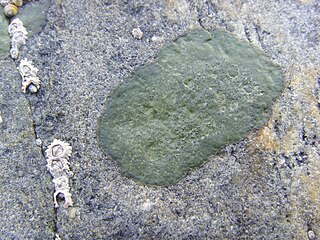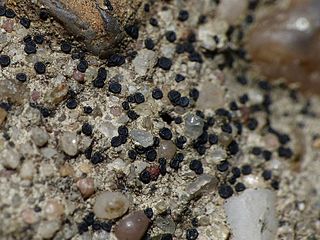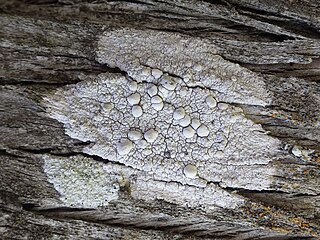
Erik Acharius was a Swedish botanist who pioneered the taxonomy of lichens and is known as the "father of lichenology." Acharius was famously the last pupil of Carl Linnaeus.

Parmelia is a genus of medium to large foliose lichens. It has a global distribution, extending from the Arctic to the Antarctic continent but concentrated in temperate regions. There are about 40 species in Parmelia. In recent decades, the once large genus Parmelia has been divided into a number of smaller genera according to thallus morphology and phylogenetic relatedness.

Opegrapha is a genus of lichenized fungi in the family Opegraphaceae. Species include:

Felipes is a genus of lichenized fungi in the order Arthoniales. Circumscribed by Andreas Frisch and Göran Thor in 2014, it contains the single species Felipes leucopellaeus. Genetic analysis shows that the genus falls into the order Arthoniales, but its familial placement is uncertain. Felipes leucopellaeus is found across Europe and North America in temperate and boreal regions, typically in old-growth forest or wooded mires. It is crustose and corticolous.
Everniopsis is a fungal genus in the family Parmeliaceae. It consists of a single species, the bark-dwelling lichen Everniopsis trulla, which occurs in Africa and South America.

Lepraria is a genus of leprose crustose lichens that grows on its substrate like patches of granular, caked up, mealy dust grains. Members of the genus are commonly called dust lichens. The main vegetative body (thallus) is made of patches of soredia. There are no known mechanisms for sexual reproduction, yet members of the genus continue to speciate. Some species can form marginal lobes and appear squamulose. Because of the morphological simplicity of the thallus and the absence of sexual structures, the composition of lichen products are important characters to distinguish between similar species in Lepraria.
Menegazzia cincinnata is a species of foliose lichen from southern South America. It was first scientifically described by Swedish lichenologist Erik Acharius as Parmelia cincinnata. Friedrich August Georg Bitter transferred it to the genus Menegazzia in 1901.

Cornicularia is a genus of lichenised ascomycetes in the large family Parmeliaceae. It is a monotypic genus, with a single currently accepted species, the saxicolous lichen Cornicularia normoerica. This species has an erect caespitose growth form, and is sometimes referred to as the brittle lichen.

Parmelia saxatilis, commonly known as the salted shield lichen or crottle, is a species of foliose lichen in the family Parmeliaceae. Several morphologically similar species, formerly lumped together, are now distinguished by their DNA.

Calicium trabinellum, commonly known as the yellow-collar stubble lichen, is a widespread species of pin lichen in the family Caliciaceae. It was first described by Swedish lichenologist Erik Acharius in 1803 as Calicium xylonellum ß trabinellum. He made the new combination Calicium trabinellum in a later chapter of the same publication.

Parmelia omphalodes is a species of foliose lichen in the family Parmeliaceae. It is one of the several dozen lichen species first described in 1753 by Carl Linnaeus. Swedish lichenologist Erik Acharius transferred it to the genus Parmelia in 1803. The lichen is widely distributed, having been recorded in Asia, Africa, Europe, and North and South Americas. Morphologically similar–but genetically distinct–species include Parmelia discordans and P. pinnatifida.

Lepraria incana is a species of dust lichen in the family Stereocaulaceae. First described scientifically by Johann Jacob Dillenius in 1741, and then formally by Carl Linnaeus in 1753, it is the type species of the genus Lepraria. The thallus of this species is green to greyish-green, and powdery – as if made of tiny granules. These granules are soredia, which are asexual reproductive structures. Like most members of genus Lepraria, the lichen has few distinguishing features, lacking both a medulla and sexual reproductive structures (apothecia). Chemically, the lichen is characterised by the presence of the secondary chemicals known as divaricatic acid and zeorin.
Coenogonium pineti is a species of crustose lichen in the family Coenogoniaceae. It was first formally described by Erik Acharius in 1810, as Lecidea pineti. Robert Lücking and H. Thorsten Lumbsch transferred it to Coenogonium in 2004 after molecular phylogenetic analysis suggested its placement in that genus. The lichen has a widespread distribution in cooler, temperate regions of the Northern Hemisphere, but has also been recorded from southeastern mainland Australia and Tasmania.

Solorina crocea, commonly known as the orange chocolate chip lichen, is a species of terricolous (ground-dwelling) and foliose (leafy) lichen in the family Peltigeraceae. The lichen, which was first formally described by Carl Linnaeus in 1753, has an arctic–alpine and circumpolar distribution and occurs in Asia, Europe, North America, and New Zealand. It generally grows on the bare ground in sandy soils, often in moist soil near snow patches or seepage areas. Although several forms and varieties of the lichen have been proposed in its history, these are not considered to have any independent taxonomic significance.

Wahlenbergiella mucosa is a species of saxicolous (rock-dwelling), crustose lichen in the family Verrucariaceae. It is a marine species that grows in the littoral zone, and therefore remains immersed in seawater for extended periods. Its photobiont partner is the green alga Paulbroadya petersii.

Verrucaria muralis is a species of saxicolous (rock-dwelling, crustose lichen in the family Verrucariaceae. It is a common species with an almost cosmopolitan distribution, occurring in an altitudinal range extending from the lowlands to the subalpine zone. It grows on calcareous rocks and walls. It was first formally described as a new species in 1803 by Swedish lichenologist Erik Acharius.

Dirina ceratoniae is a species of crustose lichen in the family Roccellaceae. It is found in Europe, where it grows on both bark and on calcium-rich rock. The lichen was formally described as a new species in 1810 by Swedish lichenologist Erik Acharius. Elias Magnus Fries transferred the taxon to genus Dirina in 1831.

Verrucaria viridula is a common and widely distributed species of saxicolous (rock-dwelling), crustose lichen in the family Verrucariaceae. Although it is a somewhat morphologically variable species, two persistent distinguishing characteristics are its relatively large perithecia, which are often curved into a beak, and its large ascospores.

Zwackhia viridis is a species of corticolous (bark-dwelling), script lichen in the family Lecanographaceae. It has a cosmopolitan distribution, and has been documented in Africa, Asia, the Americas, Europe, and Oceania.
Calicium corynellum is a species of pin lichen in the family Caliciaceae. It is found scattered across parts of Europe, North America, and Asia, where it grows on rock surfaces in shaded and humid locations.
















